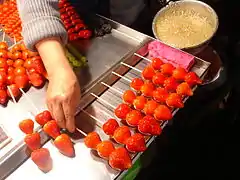Tanghulu
Tanghulu (/tɑːŋ.hulu/) or Tang hulu (simplified Chinese: 糖葫芦; traditional Chinese: 糖葫蘆; pinyin: táng húlu; lit. 'sugar calabash'), also called bingtang hulu (冰糖葫芦; 冰糖葫蘆; bīngtáng húlu; 'rock-sugar calabash'), is a traditional Northern Chinese snack consisting of several rock sugar-coated fruits of Chinese hawthorn (Crataegus pinnatifida) on a bamboo skewer. It is named for its calabash-like shape. Tanghulu is called Tang dun er (simplified Chinese: 糖墩儿) in Tianjin, Tang qiu (simplified Chinese: 糖球) in Fengyang, Anhui, Tang zhan er (simplified Chinese: 糖蘸儿) in Shandong. Tanghulu is often mistaken for regular candied fruits; however, it is coated in a hardened sugar syrup. This sweet and sour treat has been made since the Song Dynasty, and it remains popular throughout northern China.[1]
 Traditional bingtang hulu (Shanghai, 2008) | |
| Alternative names | Bingtang hulu |
|---|---|
| Type | Confections |
| Place of origin | China |
| Region or state | Cities in China |
| Main ingredients | Crataegus pinnatifida, sugar syrup |
| 200 kcal (837 kJ) | |
Chinese hawthorn is the traditional fruit used for the skewering of fruit,[2] but in recent times, vendors have also used various other fruits, such as cherry tomatoes, mandarin oranges, strawberries, blueberries, pineapples, kiwifruit, bananas, or grapes. The pits and seeds of the hawthorn are emptied out and are commonly filled with sweet red bean paste before being skewered and dipped.
Origin


During the Southern Song Dynasty, the emperor Song Guangzong (simplified Chinese: 宋光宗) had a very beloved Imperial concubine named Huang Guifei. One day, when Huang was sick, she refused to eat or drink all day long, and she seemed about to die at any moment. Palace doctors were puzzled as to how to cure her, resulting in Song Guangzong spending an exorbitant amount of money seeking medical help.[3] Later, a doctor came to the palace and treated Huang. He ordered cooks to prepare the hawthorn with rock sugar, advising Huang to take five to ten of them before each meal. Surprisingly, after a few days, Huang gradually recovered. Everyone thought this method was quite novel, so the prescription was passed down. Later, people began to string the fruit together and sell it on the street, which is now known as tanghulu.[4]
Nutrition
Tanghulu is rich in Vitamin C, pectin and chlorogenic acid, caffeic acid, maslinic acid, oleanolic acid, quercetin, ursolic acid, chrysin, epicatechin and other organic acids and nutritional elements. The Chinese Hawthorn may have medicinal effects, such as reducing the effects of constipation and dysentery and lowering blood lipids and cholesterol, although its medicinal properties have not been widely proven. However, due to its high sugar content, long-term consumption may be unsuitable for diabetics or people with other health conditions.[5]
Gallery
 Strawberry dipped with sugar coating for sale as a bingtang hulu (2004)
Strawberry dipped with sugar coating for sale as a bingtang hulu (2004)
References
- Timothy G. Roufs Ph.D.; Kathleen Smyth Roufs (29 July 2014). Sweet Treats around the World: An Encyclopedia of Food and Culture: An Encyclopedia of Food and Culture. ABC-CLIO. p. 85. ISBN 978-1-61069-221-2.
- Mary Choate and Aaron Brachfeld (31 August 2015). At Home in Nature, a user's guide. Coastalfields Press. p. 315. GGKEY:K5213DDZJD2.
- "冰糖葫芦不平凡的来历:从宫廷美食到常见小吃". hlj.ifeng.com. Retrieved 2023-02-10.
- 美食玉馔 (1970-01-01). "酸甜可口的冰糖葫芦,起源于宋朝皇妃的"富贵病"". k.sina.cn. Retrieved 2023-02-10.
- 华龙网 (2018-01-30). "冰糖葫芦营养价值大科普". news.sina.com.cn. Retrieved 2023-02-10.
External links
 Media related to Tanghulu at Wikimedia Commons
Media related to Tanghulu at Wikimedia Commons